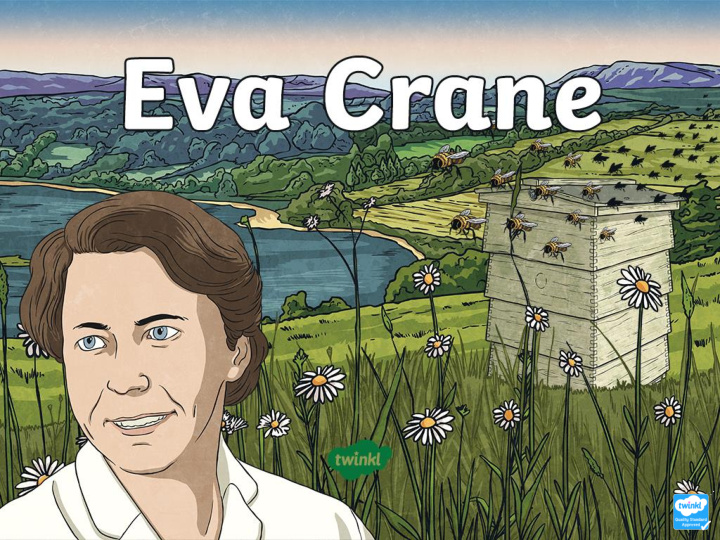



Aim Aim • To describe Eva Crane and her work with bees. Success Criteria Success Criteria • Statement 1 Lorem ipsum dolor sit amet, consectetur adipiscing elit. • I can order facts about Eva Crane’s life. • Statement 2 • I can describe Eva Crane’s research into the life cycle of bees. • Sub statement • I can describe the life cycle of bees. • I can consider the importance of bees.
What Creature Is This? Today you are going to find out about Eva Crane, a scientist who spent decades Can you work out which creature is being described? researching bees and their behaviour, becoming a world expert on these insects. They can fly at around 25km an hour. They are venomous. They communicate messages about food sources by performing a special dance. They are the only insect to produce food eaten by humans. They are extremely important pollinators of flowering plants. It has been estimated that they pollinate at least 40% of our crops. Did you work it out? All these facts describe bees !
Sequencing Use your Eva Crane Activity Sheet to place the facts about her life in order. You will need to work with a partner. On your Activity Sheet you will find a timeline of Crane's life. However, some facts are missing. Your partner has a similar timeline, but with different missing facts. Work together to complete both of your timelines, cutting and sticking the correct facts to fill the spaces.
Eva Crane Eva Crane, born Eva Widdowson, was born in 1912 in London. She was originally a physicist, and completed a PhD in nuclear physics. She was working as a Lecturer of Physics at Sheffield University when she married James Crane in 1942. The newly-married Cranes were given a beehive as a wedding present. The person who gave them the present intended them to use the honey from the hive to supplement their wartime sugar rations. Eva Crane became so interested in the bees that she started to research their behaviour and their life cycle. This began a lifetime of work and study of these special insects.
Eva Crane Between 1960 and 2000, Crane visited many countries to research different ways of caring for bees, and the differences between species of bees. She has been described as an intrepid adventurer in the pursuit of knowledge about bees. She travelled to a variety of places, including a remote corner of Pakistan, the Zagros mountains in Turkey, as well as Iraq and Iran. To get to these remote places, she travelled by different modes of transport, including dog sled, canoe and light aircraft. Crane often travelled alone, and continued to do so until she was an advanced age. Eva aimed to learn more about bees and how they make honey, so she could share her beekeeping knowledge with people around the world.
Eva Crane On her travels, Crane made a number of discoveries about bees and their life cycles. She wrote several books about her discoveries, including two encyclopaedias that are still considered to be the most important books about beekeeping. Crane founded several groups to further the scientific understanding of bees throughout the world. One of these group was the Eva Crane Trust, which still funds new research today.
The Life Cycle of Bees Eva Crane studied the life cycle of bees, and explained that their life cycle has four main stages.
The Life Cycle of Bees Crane also explained that there are three different types of bee. The queen is the only female bee able to produce eggs. She can lay fertilised eggs, which become worker bees, or unfertilised eggs, which become drones. The workers are all female, and they collect nectar for the colony. The drones are male, and their job is to mate with the queen to fertilise the eggs.
The Life Cycle of Bees Play the Beehive Board Game with your group. Guide your counter around the stages of a bee’s life cycle. Finish first to be the winner.
Bees in Decline In 1989, Crane reported her discovery that some species of bees were dying out. Since she reported this, bee populations have continued to decline. Scientists call this problem 'colony collapse disorder'. The adult bees from a hive disappear, leaving behind the queen, the eggs and the larvae. They cannot survive without the adult bees to care for them, so the entire hive dies. More than 10 million beehives have been lost to colony collapse disorder. What problems do you think this could cause? Think about what bees do and how they help us. Talk to your partner about your thoughts.
Bees in Decline When they collect nectar, bees pollinate flowers. This enables green plants to produce seeds and fruit. Crane discovered that bees are responsible for pollinating at least 40% of our food crops. Without bees, many crops would not be pollinated.
Bees in Decline Using your knowledge of plants, talk to your partner about the problems we would face if our crops were not pollinated. If a plant is not pollinated, the flower will not grow seeds, fruits or vegetables. The crops will fail. Without bees, it would be much harder and more expensive to grow the foods we like to eat.
What Did You Learn? Tell your partner about three things you have learnt today. one fact about Eva Crane's life one fact about her work with bees one fact about the life cycle of bees
Aim Aim • To describe Eva Crane and her work with bees. Success Criteria Success Criteria • Statement 1 Lorem ipsum dolor sit amet, consectetur adipiscing elit. • I can order facts about Eva Crane’s life. • Statement 2 • I can describe Eva Crane’s research into the life cycle of bees. • Sub statement • I can describe the life cycle of bees. • I can consider the importance of bees.
Recommend
More recommend